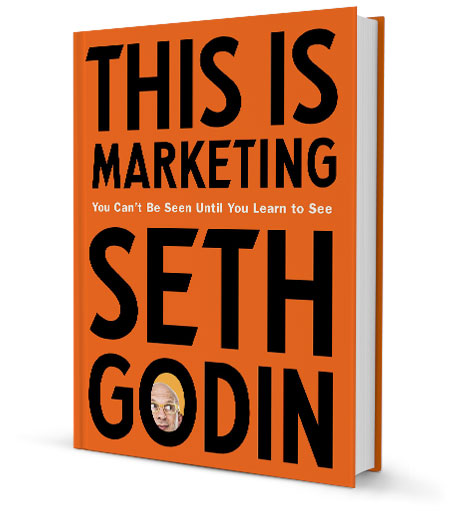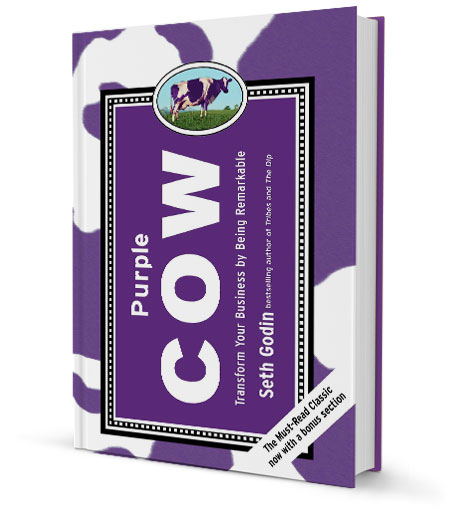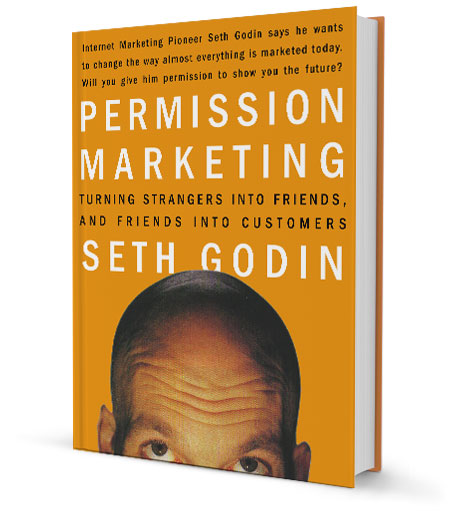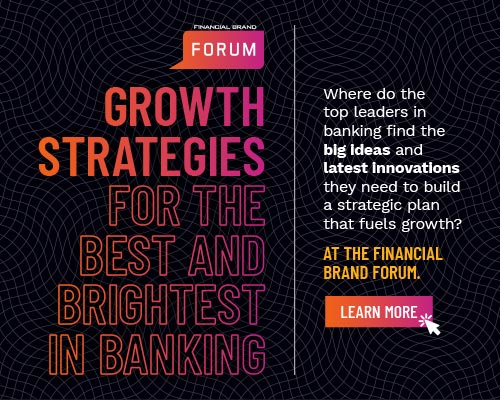For over two decades, his insights and revolutionary ideas have cemented his legacy as a demigod of digital marketing. Here’s his story, and his five Golden Rules.
Don’t miss The Financial Brand Forum — the world’s most elite conference on marketing, CX, and digital transformation for the banking industry.
In marketing circles, few people are more famous than Seth Godin. He is the author of 18 books, a member of the Marketing Hall of Fame, an entrepreneur, dotcom business executive, prolific writer, and one of the world’s most sought-after speakers. Here’s Gary’s advice for senior leaders in the banking industry looking to distinguish themselves in a crowded and noisy marketplace.
With cunning insight and sharp wit, Godin has shared his breakthrough branding concepts with a global audience numbering in the millions. Seth Godin’s unique perspective, philosophy and ideas about marketing have attracted the interest of leaders in virtually every industry.
In fact, nearly a decade ago, Mary Kuntz wrote in Business Week that Godin “may be the ultimate entrepreneur for the Information Age.” “Instead of widgets or car parts, he specializes in ideas — usually his own.” In fact, he’s as focused on spreading ideas as he is on the ideas themselves.
His impact on marketers worldwide is as massive as it is irrefutable. Fast Company founder Alan Webber said he’s so indispensable that if Godin “didn’t exist, we’d need to invent him.” Many an executive has turned their business around simply applying one of Godin’s principles — often as succinct and pithy as they are insightful.
Godin has authored nearly 20 books, some of the most notable for marketers include This is Marketing, Permission Marketing, Purple Cow, and All Marketers are Liars.
Godin honed his marketing expertise in the trenches as an entrepreneur. After a few years working as a software brand manager in the 1980s, he started his own book packaging business with $20,000 in savings. Godin later sold the business to his employees in 1995 and founded Yoyodyne internet marketing agency which specialized in permission marketing with things like online games, scavenger hunts and contests. During that time, he also wrote Permission Marketing and pioneered the concept of a non-traditional marketing technique that advertises services and goods with the consumer’s advance consent.
Yahoo! acquired Yoyodyne three years later for $30 million and named Godin the VP of Marketing. Godin later launched revenue-sharing content site Squidoo, which soon became one of the top 500 most visited websites (subsequently acquired by HubPages in 2014).
Growth Strategies and Groundbreaking Innovations in Banking
Learn how to tackle the biggest challenges in banking at The Financial Brand Forum — three days loaded with big ideas, actionable insights, and advanced strategies.
Godin’s Five Golden Rules of Marketing
1. Innovate to Break Through the Noise.
Today’s consumers are being bombarded on every level by marketing, advertising, engagement, and promotional messaging. Getting through the noise with powerful and effective marketing often starts by developing exceptional products and services.
“In a crowded marketplace, fitting in is a recipe for failure,” Godin says “Not standing out is the same as being invisible.”
The cure? Innovation.
“Doing what you’ve been doing is going to get you what you’ve been getting,” Godin observes. “The art of moving forward lies in understanding what to leave behind.”
“Don’t try to be the ‘next.’ Instead, try to be the other, the changer, the new,” recommends Godin. ” If you use your money to create exceptional products and services, you won’t need to spend it on advertising. The cost of being wrong is less than the cost of doing nothing.”
Godin lays down gems like this — insights that cut through all the corporate BS — effortlessly. They come to him as naturally as breathing. And it’s hard to argue with the simplicity of his genius.
“If you are deliberately trying to create a future that feels safe, you will willfully ignore the future that is likely,” he continues. “If failure is not an option, then neither is success.”
All sage words of both wisdom and caution for traditional financial institutions.
“Organizations that destroy the status quo win,” says Godin. “Whatever the status quo is, changing it gives you the opportunity to be remarkable.”
If you work in banking, you can just hear the footsteps of fintechs sneaking up behind you. They get it.
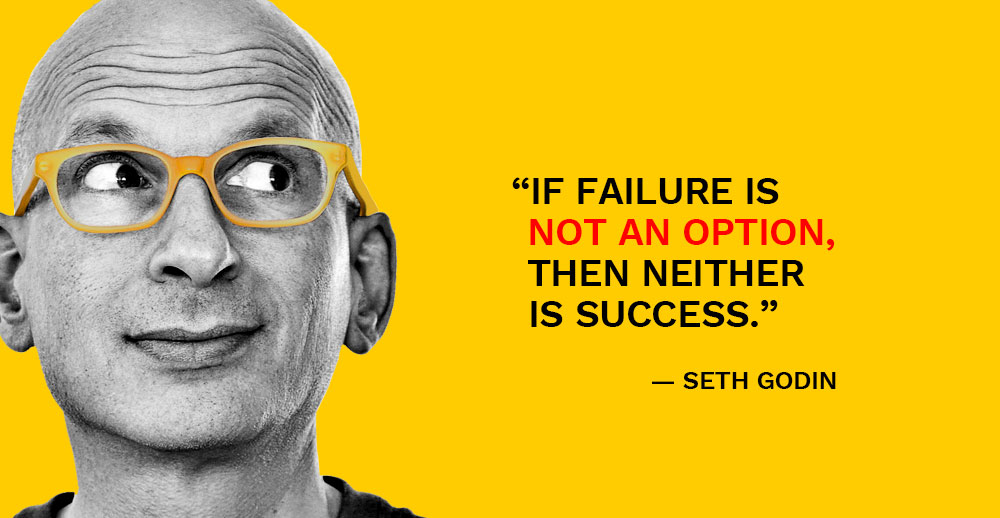
2. Building Trust Breeds Brand Advocacy.
Bad marketing just interrupts customers with hype and pressure. But effective marketing helps people. Godin encourages financial marketeers to tap into humility and empathy to understand the customer’s world. “The only way to make a difference is to truly see and understand the people you seek to influence,” he says.
Which is why Godin believes in the concept of “smallest viable audience”, where you identify and focus on the most narrow, most important segment that is economically viable and sustainable. Find that audience — no matter how small — focus on them, then strive to get them to tell others. In other words, cultivate brand advocates, brand disciples.
“There’s so much noise in the world, it’s become an epidemic. It’s created a palpable distaste among consumers who have no interest in hearing from anyone they don’t care about. Marketing that works is marketing that people choose to notice.”
In his book This is Marketing, Godin says that the most effective marketing revolves around creating connections and building trust. As consumers ultimately care about their own self-interests, gaining their trust entails showing them you care — about them and their priorities — and that you can solve problems in their life.
“As soon as engaging with your brand is a way of expressing their care, they’ll happily do it,” he said in an interview with Forbes. “It’s easier to love a brand when the brand loves you back.”
And that is more important than ever at a time when trust in so many institutions is eroding.
“We’re all looking for someone we can trust, something we can believe in — people and institutions that will do what they say, and say what they mean,” he explains.
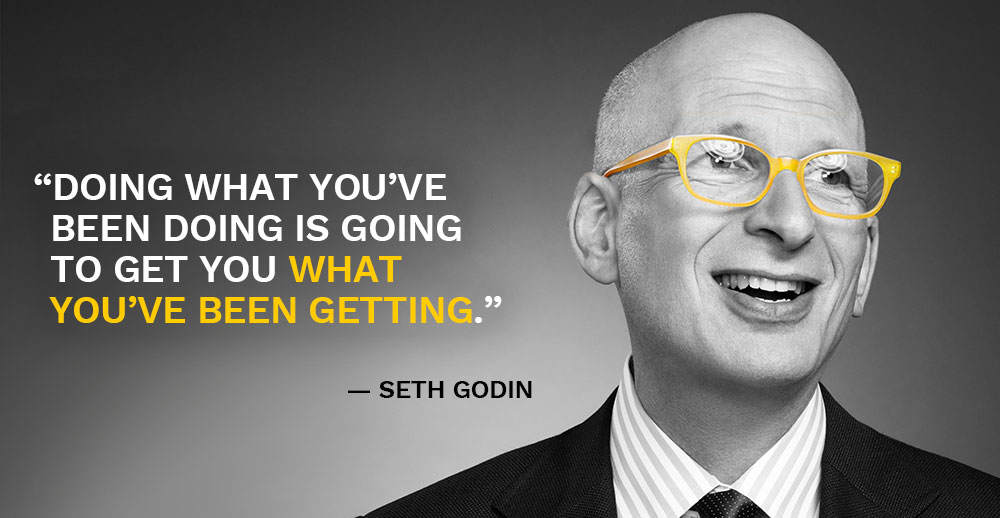
3. Be Authentic, Be Consistent.
Most marketing leaders would say “authenticity and consistency are more important than ever before,” but Godin believes these are misunderstood concepts — largely lip service. It doesn’t mean blog posts laden with tropes and trite brandspeak ghost-written for the CEO. And it doesn’t mean delivering the same options and services across various touchpoints.
“A brand is more than a logo. It means you made a promise,” Godin says. “Consistency means you keep that promise, and behave how people expect you to behave. Making promises and keeping them is the only way to build a brand.”
“Brands fall apart when we discover that — behind the scenes — you’re not who we thought you were. But if you’re consistent in being who people think you are, then you’re seen as authentic. When we’re seen as authentic the promise of the brand becomes more valuable,” Godin said in an interview.
Godin is a firm believer in content marketing, and a strong proponent of storytelling (more on that in just a minute). “Living and breathing an authentic story is the best way to survive in a conversation-rich world,” he argues. Brand marketers must tell an authentic, consistent story.
People have pretty good BS detectors. The very moment your story begins to seem fake or phony is the very moment your audience will tune out and turn off. If your story is not believable, it’s going to fall flat on its face, and it won’t make an impression.
“Getting out of a top-down mindset is key to building a story for your organization that works,” Godin explains. No one likes a story lacking authenticity, so Godin recommends that these stories always come from “someone in the trenches” who actually knows what they are talking about.
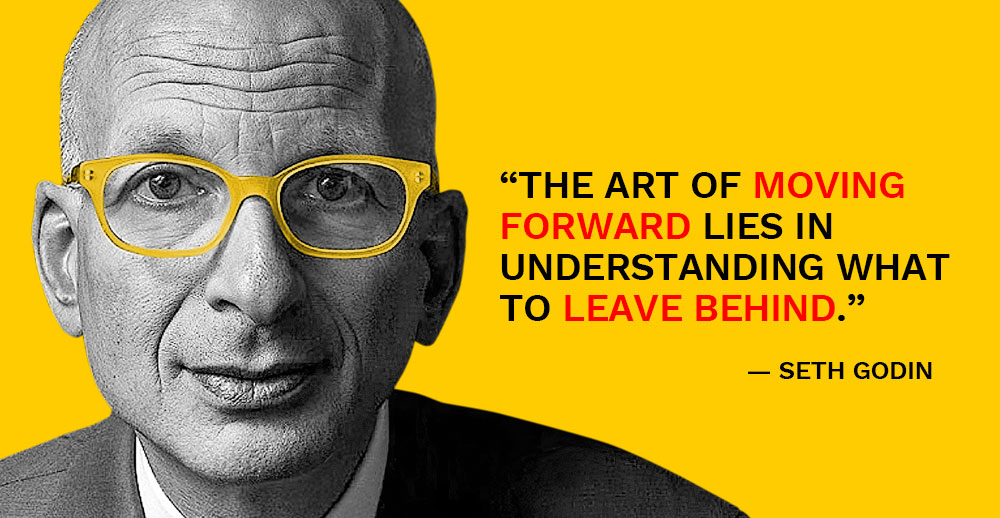
4. Tell Great Stories.
As Godin is fond of saying, “Marketing is no longer about the stuff you make, but the stories you tell.” Customers don’t buy a product, they buy a story. And when done right, people believe them.
“Marketing is storytelling,” Godin says. “Stories make it easier to understand the world. Stories are the only way we know to spread an idea. Marketers didn’t invent storytelling. They just perfected it.”
What marketers should be selling is not just the concrete value of the product, but the experience consumers get if they buy it. In other words, focus on outcomes — sell the benefits, not the features of your products.
And storytelling goes way beyond advertising. “It’s the story of your product, built into your product,” explains Godin. “The ad might be part of it, the copy might be part of it, but mostly, your product and your service and your people are all part of the story. Tell it on purpose.”
“Great stories succeed because they are able to capture the imagination,” Godin continues. “Great stories don’t appeal to logic, but they often appeal to our senses. Pheromones aren’t a myth. People decide if they like someone after just a sniff.”
In his book All Marketers are Liars, Godin says marketers must ask themselves what story they are trying to communicate from a 30,000-foot view. What’s the most compelling information? What’s the most important takeaway? How can you communicate your main point most effectively in a story framework?
“Great stories are subtle,” Godin points out. “Surprisingly, the fewer details a marketer spells out, the more powerful the story becomes. Talented marketers understand that allowing people to draw their own conclusions is far more effective than announcing the punch line.”
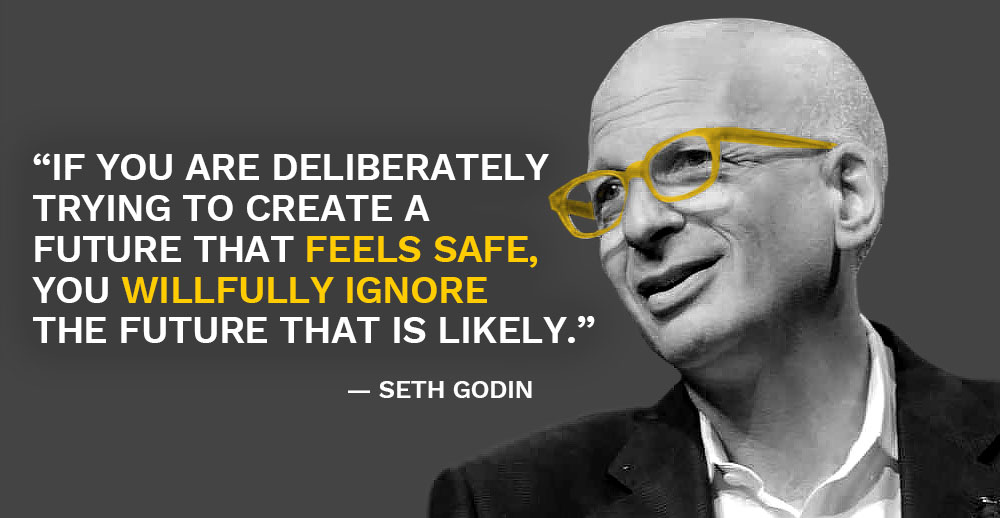
5. You Can’t Make Social Media About Numbers
“Build it, and they will come only works in movies like Field of Dreams,” Godin quips. “Social media is not like that. It’s more like ‘build it + nurture it + engage them… then they may come and stay.’”
According to Godin, the reason social media is so difficult for most financial marketers is that it’s a process, not an event.
Godin stresses that social media isn’t a tactic. It’s impact is actually a symptom, usually a result — good or bad — caused by other actions the brand has taken. He notes that brands with ten or twenty times the social media impact almost never have 10-20 times as many people working as “social media specialists.”
In simple terms, great brands get great results in social channels, whereas mediocre and lousy brands have to work much harder to find any traction. If you have a remarkable brand, well… people will naturally make remarks about it.
“If you manage your brand the right way, people will talk about you in social media,” Godin explains. “But this idea that you can mechanize and cognify and just give people a script that they will keep burning through on social media — there is no evidence that this works.”
“You want to build a thing that will cast a shadow on social media,” Godin explains. “But social media is not your source of light.”
Godin emphasizes that the effectiveness of social media isn’t about numbers or reach (getting people to see it), but rather about creating true stories that — when they intersect with people who want to hear them — change those people for the better. And that’s not easy, which is why so many financial institutions tend to have lackluster results.

